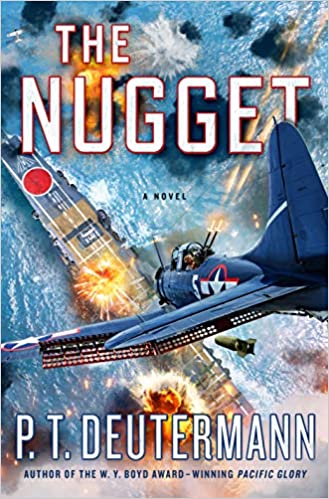Reviewed by Capt. C. Herbert Gilliland Jr., USN (Ret.)
Waking from a drunken evening, newly minted dive-bomber pilot Robert Steele finds himself in Pearl Harbor aboard the battleship Oklahoma. From that ominous moment, almost as though he wanted to cover the entire Pacific war in this single book, retired Navy Captain Deutermann shows us life and death in various terrifying ways at sea, as well as ashore.
The novel’s title comes from the nickname for an air squadron newbie, which Steele is when he reports to Enterprise’s air group. Taking part in the Battle of Midway, “Nugget” scores a direct hit on a Japanese carrier and earns the new nickname “Fish.” Caught up in the swirl of the Pacific war, Fish and his gunner “Rooster” take part in an impressive variety of combat action involving ships, aircraft, and Marines.
Does our hero experience (and survive) too many astonishing events? Maybe so, but the reader cheerfully lets the action carry him along. Many well-researched details are woven so skillfully into the action that—for example– the reader, certain the author never flew a dive bomber himself, is sure he must have had an ancient pilot at his elbow when writing those passages. We hear thoughts such a pilot might express: the inferiority of American torpedoes to Japanese ones; General MacArthur’s nickname “Dugout Doug”; concern about running out of fuel before completing the mission. In his first-person narration, Steele also shows an appreciation for what non-aviators may face. He comments, for example, that being on a submarine under attack was “much scarier” than dogfighting Zeros, because “there was nothing we could do about it.” (Your reviewer once heard that exact phrase from a U-boat veteran.) Steele reflects further that a downed pilot might be rescued or at least be seen to go down, but a sunken submarine just disappears with its crew.
Occasional moments of introspection suggest the less visible costs of combat. Excited by his squadron’s success against the Japanese carriers, Steele later realizes that he had not even thought about his lost squadron-mates. And although Pearl Harbor had been more than enough to make him eager to “kill Japs,” he was not unmoved that thousands had just died under his squadron’s attack. Much later he becomes very conscious of the more than physical difference between killing by dropping a bomb from high above the target, and the very personal killing involving intimate contact with the enemy and the resulting “puddles of gore.” With another character, Steele also recognizes the blood lust that close combat may readily bring. What line is crossed, we are invited to wonder, when the warrior moves from motivations of survival, duty or even revenge, to sheer pleasure?
Nearly going down with the carrier Hornet, Fish and Rooster are rescued by the submarine Hagfish. Our aviators experience too briefly the unique demands of the silent service before finding themselves on the Japanese-occupied island of Talawan. Over half the novel is devoted to the irregular warfare on Talawan. There the two Americans encounter Japanese troops under the command of the appallingly brutal Colonel Tachibana. Besides the occupying Japanese, Deutermann’s Talawan offers an exotic mix of people. These include an exiled Catholic priest, British POWs, villages of Christian fishermen, Moslem moros, and blowgun-armed Negritos. The groups’ mutual hatred of the Japanese does not suffice; it takes our aviators’ engagement and resolve to unite them. Involving all of these in a struggle against Tachibana generates a plot sequence that some readers may find more elaborate than plausible. However, Deutermann’s narrative skill and talent for surprise keep things moving to an unforgettable end.
Wrapped around this main narrative is a framing device, a Naval Board of Inquiry. In the opening chapter this hooks the reader with the question of Steele’s identity. In the final chapter, the Board brings us back to what is, in comparison to everything experienced in the meantime, a kind of normality and a satisfyingly nuanced resolution.
Given today’s heightened cultural sensitivity, the language in a novel like this might raise questions. Deutermann’s Japanese are—to his characters—“Japs,” as they were to every American serviceman during World War II. Though a disclaimer might be expected by some readers, most who pick up this book will take the language for what it is, true to its time and place. This reader is convinced it would be silly to do otherwise.
Nugget is one more of Deutermann’s popular World War II novels. Loyal readers will like this one, and readers new to this author will as well. Very much at home in the historical context, Deutermann is also a seasoned writer of thrillers, so that his fact and fiction harmonize engagingly. Oddly, this reviewer received Nugget only a month ago, though it was published in 2019. The good news is that if you like this one, two more have since come out.
Capt. C. Herbert Gilliland, Jr., USN (Ret.) had a lengthy career teaching at the US Naval Academy, and is currently working on a biography of artist A.K. Murray.
The Nugget. By P. T. Deutermann (New York: St. Martin’s Press, 2019).


